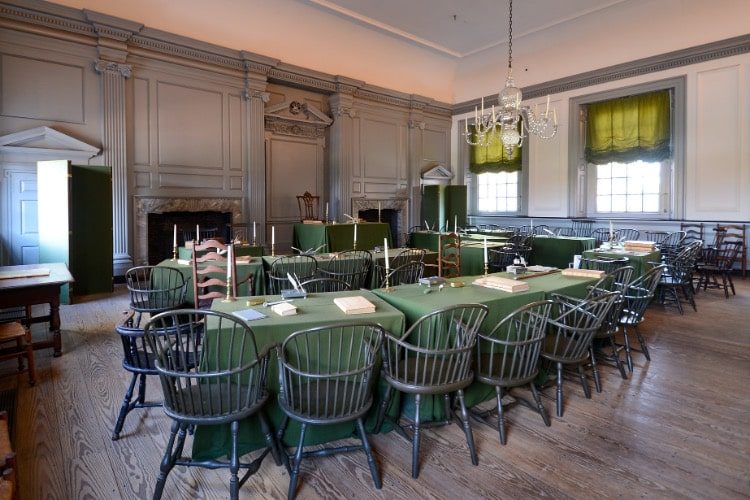
Tension mounted in the Pennsylvania State House as delegates at the Constitutional Convention of 1787 continued their sometimes heated debate over how to apportion representation in the House of Representatives. There were times in July, 1787 when the Convention seemed deadlocked between the representatives of small states and those of the larger states. There was, additionally, the issue of how to account for slaves in the calculation of a state’s population. States where slavery was legal and a significant factor in their economy wanted slaves counted in the census that would determine the number of representatives allotted to the state. These states were joined by a couple of states in the north where the slave trade was a profitable occupation for many ship owners, businessmen whose bottom lines would be damaged by an outright prohibition on slavery.
As I have covered in an earlier article in this series, there was a compromise — the “Great Compromise” — worked out that pleased all of the states a little and none of the states completely. That achievement was yet to come, however, as the eyes and attention of most of the delegates now turned to New York City.
It is often forgotten, in light of the historically unequaled influence of the Constitutional Convention, that the Confederation Congress was still carrying on business. Meeting in New York City, the Confederation Congress (officially “the united States in Congress, Assembled”) was functioning as the lawmaking body created under the then-binding constitution: the Articles of Confederation.
Occasionally, representatives from the Constitutional Convention would travel to Congress to keep apprised of happenings there and how they would effect their respective states, and occasionally congressmen would visit Philadelphia to see if they were being amended out of a job! The two assemblies certainly kept up with the goings on in each other’s deliberations, particularly if there was an especially important issue be debated or up for a vote.
On July 13, such an issue was passed by Congress and the provisions of that measure that was approved influenced the trajectory of the Constitutional Convention. That historical and influential legislation was the Northwest Ordinance. A law rarely spoken of today, its impact on American history cannot be overstated. This remarkable piece of legislation laid the groundwork for the entry into the union of many new states and for the opportunity to shape the future of the union and how its expansion would be managed.
Here’s just a bit of background on the Northwest Ordinance.
The Northwest Territory, an enormous expanse northwest of the Ohio River, was at the center of attention. It held the promise of fertile lands, abundant resources, and the potential for future states.
Enter the Northwest Ordinance. This historic act, passed by the Continental Congress, laid out a blueprint for the territorial governance of these new lands. But it did much more than that. It served to enshrine the principles of freedom, justice, and republican government at its core.
Under the Northwest Ordinance, the territories would undergo a three-stage process toward statehood. Initially, they would be governed by Congress-appointed officials. As the population grew, residents would gain more autonomy, electing their own assemblies. Once a territory reached a population of 60,000 free inhabitants (so determined because that was roughly the population of Delaware, the smallest state), it would be eligible to apply for statehood, on an equal footing with the original 13 states.
Perhaps most strikingly, the Northwest Ordinance explicitly banned slavery in these territories. In a time when the practice was deeply entrenched in many parts of the country, this bold decision reflected a commitment to the principles of liberty and equality. It set a precedent that would reverberate throughout American history, a reverberation that would work to set the stage for the bloodiest war: the Civil War.
Now, back to the Constitutional Convention. During the debates on representation in the House of Representatives, Gouverneur Morris, Elbridge Gerry, and others expressed considerable concern that the admission of territory in the West into the United States would dilute the influence of the Eastern states, as well as place them at a disadvantage economically and electorally.
“If the Western people get the power into their hands, they will ruin the Atlantic interests,” Morris said.
Gerry echoed his colleague’s concern, predicting that “they [Western people] will oppress commerce and draw our wealth into the Western Country.”
According to the notes kept by James Madison, Gerry went on to suggest limiting the number of states that could be admitted to the union in a way that “they should never be able to outnumber the Atlantic States.”
As expected, delegates from the South did not share these fears.
“People are constantly swarming from the more to the less populous places — from Europe to America, from the Northern and Middle parts of the United States to the Southern and Western. They go where land is cheaper because their labor is dearer,” Madison explained.
Although Congress passed the Northwest Ordinance on July 13, 1787, the subject of that statute had been percolating for years.
In 1784, Thomas Jefferson drafted a resolve establishing rules for the government of the lands ceded by the states and by Great Britain to the United States. And although it might sound unbelievable to some, Jefferson’s proposal was the first suggestion that slavery be abolished in the entire territory: from Florida to the boundary with Canada. Congress rejected Jefferson’s plan.
Two years later, in 1786, a committee headed by James Monroe of Virginia drafted a similar ordinance, but this one contained no reference to slavery at all.
It was evident by the failure of Congress to make any meaningful step toward a set rules for the territories’ admission as states that the power and jealousy of the Northern states held significant sway for some time.
In March, 1787, a number of military officers and other investors met in Boston and formed The Ohio Company, for the purpose of making settlements north of the Ohio River. The company’s leaders applied to Congress for the purchase of lands adequate to their purpose, offering to purchase 1.5 million acres for $1 million. Such a proposal could contribute to the reduction of Congress’s debt and was thus welcomed by Congress.
A committee was appointed on July 9 to draft an ordinance for the government of this new Western territory. On July 11, the committee, led by Richard Henry Lee of Virginia, produced an entirely new ordinance that included provisions for freedom of religious worship, a bill of rights, prohibition of slavery, and a clause making the following significant provision:
In the just preservation of rights and property, it is understood and declared that no law ought ever to be made or have force in the said territory that shall, in any manner whatever, interfere with or affect private contracts or engagements, bona fide and without fraud, previously formed.
This would essentially require the people living in these territories to return runaway slaves to their “owners.”
While that’s lamentable, it is remarkable and praiseworthy that the Northwest Ordinance of 1787 explicitly outlawed slavery in the new territories. Although Richard Henry Lee, Rufus King, and Nathan Dane have all been given credit for this historic provision, the irrefutable fact is that the honor and credit for having been the first to suggest that slavery be prohibited in the new territories — and in any and all additional territories that would later be added — belongs to Thomas Jefferson.
On July 13, 1787 Congress passed the Northwest Ordinance by a unanimous vote of the eight states present (the representatives from Pennsylvania, Maryland, New Hampshire, Connecticut, and Rhode Island were absent that day).
The repercussion of the passage by Congress of the Northwest Ordinance was felt in Philadelphia. Many delegates at the Constitutional Convention decided that in light of that new law, things needed to be decided one way or the other by the Convention and that the whole plan should be put to a vote, letting the chips fall where they may.
In the words of Luther Martin:
I call for the question on the whole report. I do not like it, but I am willing to make trial of the plan rather than do nothing. I am willing, however, to let the large states separate from the rest and have two confederacies, rather than abandon the principle of equality of representation in the Senate.
James Madison and James Wilson were not convinced that the convention would end and they persisted in their opposition to the compromise. They would not vote in favor of the states being represented as states and would only accept a government with representation determined according to the population of the states.
A vote was taken on the issue of equality of representation of the states in the Senate and it failed, six votes against and four in favor.
It was now Saturday, though, so the delegates would have Sunday to cool off, confer, and consider whether the business of the convention would carry on or whether it was time to adjourn for good.



